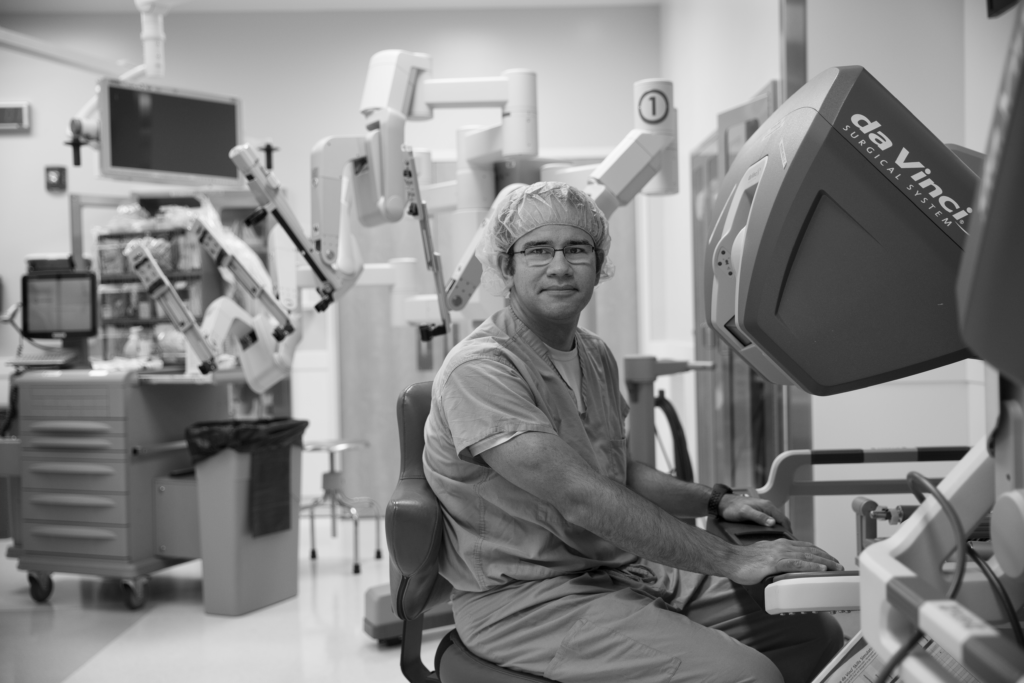Transforming Treatment for Paratesticular Rhabdomyosarcoma in Adolescents through Robotics
Transforming Treatment for Paratesticular Rhabdomyosarcoma in Adolescents through Robotics https://pediatricsnationwide.org/wp-content/uploads/2024/01/091317BS0041-1024x683.png 1024 683 Erin Gregory Erin Gregory https://secure.gravatar.com/avatar/?s=96&d=mm&r=g- January 22, 2024
- Erin Gregory

Retroperitoneal lymph node dissection (RPLND) has been a crucial component of treating testicular and paratesticular cancers for over a century. Recent advancements in minimally invasive techniques, such as robotic-assisted methods, have expanded the applicability of RPLND, offering reduced morbidity and faster recovery. However, concerns persist regarding the equivalence of oncological outcomes compared to traditional open surgery.
In a study published in the National Library of Medicine: “Robotic retroperitoneal lymph node dissection for paratesticular rhabdomyosarcoma in adolescents: a case series,” Daniel DaJusta, MD, member of the Section of Urology at Nationwide Children’s Hospital and clinical assistant professor of Urology at The Ohio State University College of Medicine, and Cody Clark, urology research aide in the Kidney and Urinary Tract Center, Nationwide Children’s Hospital, explore the use of robotic RPLND in adolescents with paratesticular rhabdomyosarcoma (RMS), presenting the largest retrospective case series to date.
The Hidden Incision Endoscopic Surgery (HIdES) Technique
The study focuses on patients at Nationwide Children’s who underwent robotic RPLND for paratesticular RMS between 2017 and 2023. All patients had previously undergone radical orchiectomy, and demographic, surgical, and follow-up data were collected. The innovative use of the hidden incision endoscopic surgery (HIdES) port position technique for robotic RPLND is a key aspect of the study.
The study includes five patients with a median age of 16.1 years. The median tumor size was 4.5 cm, and the majority had right-sided primary tumors. The robotic surgery, performed successfully in all cases, demonstrated a median operating room time of 456 minutes. Post-operative outcomes showed a median opioid use of 1.8 morphine equivalent/kg, a median length of stay of 3 days, and a median lymph node yield of 27. Only one patient experienced post-operative complications, a pneumothorax related to central venous port placement.
Understanding Barriers to Treatment
The study addresses the importance of RPLND in treating paratesticular RMS in patients older than 10 years, as recommended by the Intergroup Rhabdomyosarcoma Study Group (IRS). Despite this recommendation, a significant number of patients do not undergo RPLND for unknown reasons, possibly due to barriers such as low surgical volumes and concerns about prolonged recovery. Robotic RPLND, as demonstrated in this study, offers a feasible, safe, and minimally invasive alternative, overcoming these barriers and ensuring prompt initiation of chemotherapy.
“Furthering our understanding to barriers such as patient or provider education, or ways to enhance current techniques, will allow us to reach more children who are impacted and provide better treatments,” Dr. Dajusta said.
Future Prospects and the Need for Continued Research
This case series establishes the feasibility, safety, and efficacy of using robotic RPLND for paratesticular RMS in adolescents. The implementation of the HIdES technique did not compromise the procedure’s success and offered improved cosmesis. While acknowledging the study’s limitations, including a small sample size and lack of a comparison group, the findings suggest that robotic RPLND has a clear role in treating this rare condition.
“Future steps would include both a larger cohort as well as a comparative cohort of patients who have undergone open RPLND for paratesticular rhabdomyosarcoma,” Clark said. “Given the rarity of those who are impacted, there is a challenge performing this kind of analysis. This could open more avenues of collaboration with other institutions.”
Continued advocacy for protocol adherence and widespread adoption of minimally invasive techniques is crucial for enhancing patient outcomes. Future research should consider multicenter studies to broaden the evidence base and explore this promising approach further.
Reference:
Clark CN, Smith J, Fuchs ME, Ching CB, DaJusta DG. Robotic retroperitoneal lymph node dissection for paratesticular rhabdomyosarcoma in adolescents: a case series. J Robot Surg. 2023;17(6):3045-3048.
Image credit: Nationwide Children’s
About the author
-
Erin Gregoryhttps://pediatricsnationwide.org/author/erin-gregory/September 27, 2023
-
Erin Gregoryhttps://pediatricsnationwide.org/author/erin-gregory/
-
Erin Gregoryhttps://pediatricsnationwide.org/author/erin-gregory/
-
Erin Gregoryhttps://pediatricsnationwide.org/author/erin-gregory/January 4, 2024
- Posted In:
- Clinical Updates
- In Brief
- Research







